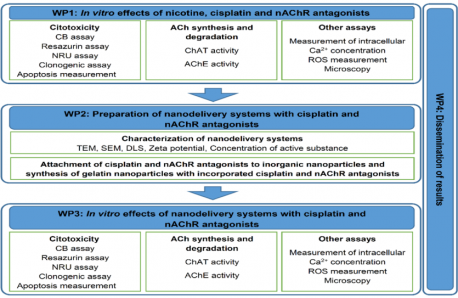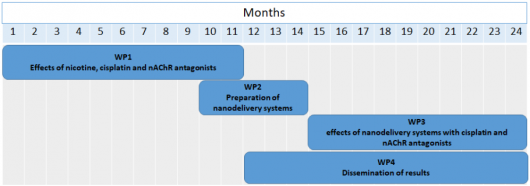Contract number
Z1-2634
Department:
Department of Biology
Type of project
ARIS projects
Type of project
Postdoctoral projects
Role
Lead
Financing
Duration
01.09.2020 - 31.08.2022
Total
1 FTE
Project manager at BF
Kononenko VenoABSTRACT
Lung cancer is the most commonly diagnosed cancer and the leading cause of cancer death. Major problems in the treatment of lung cancer are the indiscriminate action of drugs on healthy cells and cancer resistance to chemotherapy. Studies on substances that inhibit or stop cancer progression play a vital role in the development of new and effective lung cancer therapies. Smoking is a major risk factor for the development of lung cancer. Nicotine is a component of tobacco responsible for addiction to smoking. It also acts on the non-neuronal cholinergic system, leading to the promotion of lung cancer cell proliferation and the prevention of cancer cell apoptosis, as well as playing an important role in the promotion of angiogenesis and the metastasis of cancer cells. The binding of nicotine and acetylcholine (ACh) produced by cancer cells to nicotinic acetylcholine receptors (nAChRs) on lung cancer cells activates various signaling pathways that increase lung cancer invasiveness and cancer cell resistance to chemotherapeutics. A better understanding of the role of nAChR in lung cancer development and progression has raised the idea of using nAChR antagonists that would reverse the effects of nicotine and ACh for therapeutic purposes. However, their anticancer activity has only been investigated with a few types of nAChR antagonists. Many of the known antagonists do not act selectively on nAChR subtypes that are overexpressed in lung cancer cells (especially the α7-nAChR subtype). Non-selective nAChR antagonists can cause adverse effects by acting on the nAChR subtypes expressed on non-cancerous cells. In order to avoid such adverse effects, it is necessary to ensure that a given antagonist acts predominantly on cancer cells. This can be achieved by using nanodelivery systems that are preferentially uptaken by cancerous cells. The fast advancement of nanotechnology brings new opportunities for using nanoparticles as drug delivery systems targeted towards cancer cells that function more safely and effectively than traditional cancer drugs.
In our project, we will examine the in vitro effects of various nAChR antagonists on human lung adenocarcinoma cells (cell line A549), which express a large number of α7-nAChRs. The effect of nAChR antagonists will also be tested on human colon cancer cells (HT29 cell line), which in comparison to A549 cells, express a very small number of α7-nAChRs. We will use nAChR antagonists which are known to have anticancer effects (hexamethonium and 3-alkylpyridinium saltAPS8), as well as compounds that have the potential to act as nAChR antagonists based on their structure (various 3-alkylpyridinium salts: APS7, APS7-2, APS8-2, APS12-2, and APS12-3). In addition to the effects of free antagonist molecules, we will also examine how different nanodelivery systems with adsorbed or embedded antagonists influence the observed effects. We will examine the concentration- and time-dependent influence of various nAChR antagonists (free and embedded in nanodelivery systems) on the proliferation, viability, and apoptosis of A549 and HT29 cells. Anticancer efficacy of cisplatin (a commonly used chemotherapeutic drug in the treatment of lung cancer, to which cancer cells often become resistant) in combination with various nAChR antagonists (free and embedded in nanodelivery systems) will also be evaluated. In addition, we will evaluate how a chemotherapeutic (cisplatin), an nAChR agonist (nicotine), and nAChR antagonists influence the activity of enzymes involved in the synthesis and degradation of ACh, which acts as an autocrine growth factor for lung cancer cells. The results of the proposed postdoctoral project will bring about new knowledge on the impact of nAChR antagonists on lung cancer cells and the development of nanodelivery systems for lung cancer treatment.
THE PHASES OF THE PROJECT AND THEIR REALIZATION
We developed a work plan consisting of four work packages (WPs), each with specific methodological approaches which are schematically presented in Figure 1. The timetable of the project can be seen in Figure 2.
Figure 1: Schematic presentation of the project with work packages (WPs).
Figure 2: Timetable of the project with work packages (WPs) and set timeframes.
External link to SICRIS link Open in new window


